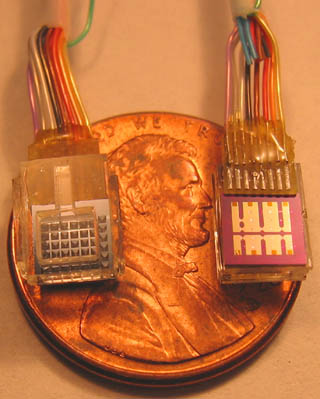Ceramics Processing Research Laboratory
Research @ CPRL
Prof. Michael Cima's researchers are applying micro- and nanotechnology to solving the looming energy crisis and advancing medical technology.
MEMS Drug Delivery Devices

MEMS-based drug delivery device.
Nanoparticle-based Cancer Biomarker Sensor
We are developing miniature medical implants for cancer detection and monitoring. The implant will contain wells filled with nanoparticles that can report on the conditions inside the tumor microenvironment, including concentrations of cancer biomarkers or chemotherapeutic drugs. This tool may be able to provide physicians and patients real-time information on the efficacy of treatment regimes.
Technologies for local monitoring of cancer biomarkers and chemotherapeutic drug concentrations will have far-reaching impact on cancer research and clinical care. The need is particularly important for monitoring the efficacy of treatments to bulky cancers with restricted delivery, or to cancers requiring optimized and personalized approaches. This project combines the sensing capabilities of nanoscale magnetic relaxation switches (MRS) and the versatility of microfabricated structures to create an implantable sensor that would be read by MRI. MRS are magnetic iron oxide nanoparticles that can be functionalized to detect a variety of analytes (Perez, Nature Biotech 2002). The presence of analyte causes the MRS to aggregate, causing a change in T2 (transverse spin-spin relaxation time). MRS are packaged into a device to contain and expose the MRS to the tumor milieu.
MRS were functionalized to detect the beta subunit of human chorionic gonadotrophin (hCG), which is elevated in testicular and ovarian cancers. The addition of hCG-▀ to the MRS resulted in T2 shortening as seen in test-tubes and in prototype devices by NMR spectroscopy and MRI respectively. This biomarker sensor is being tested in cell lines producing hCG-▀ and in nude mice bearing ectopic tumors. This is the first nanoparticle system to detect hCG-▀ cancer biomarker via T2 shortening. This is also the first demonstration of T2 shortening response inside a semi-permeable implantable device. This method can be adapted to detect other circulating biomarkers.
High Temperature Superconductivity Research
Physical vapor deposition methods for growing YBCO can produce very thick films (>5 Ám) that carry > 1 MA/cm2 current density. The consensus among the industry, however, is that PVD methods cannot achieve practical production rates for reasonable capital expenditures. A promising alternative method for the production of YBa2Cu3O7-d (YBCO) superconducting wires is metal-organic deposition (MOD). This process involves coating buffered nickel-alloy substrates with a solution containing metal-organic salts, and then firing the coated tapes to produce a biaxially textured layer of YBCO. The MOD process is scaleable from pilot to industrial scale with very small, incremental capital expenditures, and is therefore extremely attractive from an economic perspective.
The performance of YBCO layers degrades with thickness for all processing techniques, but the performance of single-layer MOD films drops off by orders of magnitude for film thicknesses greater than about 1 Ám. PVD deposited film performance drops to a "bulk" value with increasing thickness, but MA/cm2 performance is easily obtained for films 4-5 times thicker than the thickest MA/cm2 MOD-derived films. The film thickness (per layer) only slightly influences the total time required to form a film by the MOD process, so increasing thickness increases the current carrying capacity of the wire at almost no additional cost of production. The time to produce PVD films is directly proportional to the thickness, so there is no such advantage to producing thick films. Thus, there is strong interest in making very thick MOD-derived YBCO layers.
This work will examine the physical differences in PVD vs. MOD films. The work will examine only ex situ processes, that is, processes that perform the actual formation of YBCO in a separate process from the deposition of the film. Researchers at Brookhaven National Labs have produced 5 Ám films with >1 MA/cm2 current density by depositing Y2O3, CuO, and BaF2 using e-beam evaporation and subsequently annealing in oxygen and water vapor to produce YBCO. This process has long been assumed to be chemically similar to the trifluoroacetate (TFA)-based MOD process, which produces films of Y, Ba, and Cu oxides and fluorides that are subsequently annealed in oxygen and water vapor to produce YBCO. The performance of thin films produced by these processes is identical, but the drop off in performance for thick films is extremely different.

